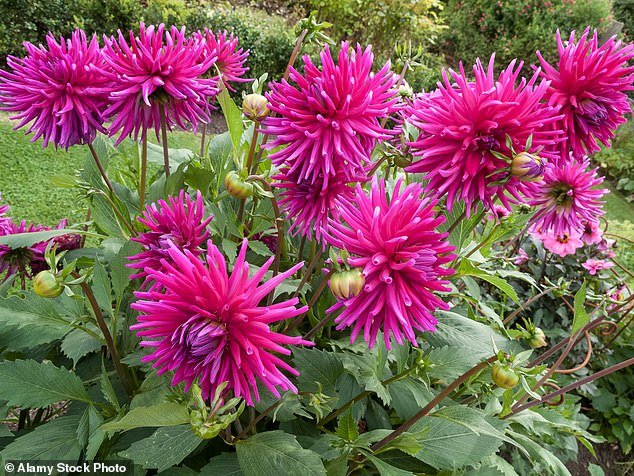Bright and beautiful: Now is the time to plant vibrant blooms for a show that lasts all year
- Nigel Colborn shares advice for a beautiful garden bursting with colour all year
- British gardening expert says white or soft blues go well with silvery-grey leaves
- He warns all-white gardens are a popular idea but difficult to get right
While winter does its worst, let’s stay cosy and think about colour. Whatever your garden’s style, most of the colour comes from plants.
They’re the living green mantle, issuing colour and fragrance throughout the year. With green as a background, flowers and foliage provide everchanging seasonal pictures. But to sustain interest, the planting must be carefully planned.
With long-term features such as borders, small adjustments can make big improvements. Planting a colourful evergreen might transform a dull corner.
Re-arranging a few perennials next month could double the beauty of a summer show.
Hot enough for summer: Purple Gem Dahlias will bloom massively from July
But unlike paint and wallpaper, plants don’t always give expected results. Spring flowers can rush out in a mild February or skulk until April in a cold year. A sweltering May can burn up blossom, and June thunder storms could wreck your roses.
But with wise planting we can reduce unforeseen problems and enjoy beauty every day, all year. Having a plan helps but you also need to be flexible.
RULES OF COLOUR
If you know how colours work, it’s easy to plan for a beautiful and changing show. We know that hot tones such as orange and red contrast with cooler blues and greens.
They also blend sweetly with foliage in bronze, purple or silver as well as green.
Pastels such as lilac-mauve or primrose make gentle blends. Pink, white or soft blues go well with silvery-grey leaves. But yellow, maroon or crimson flowers also team with silver leaves.
Sapphire blue anchusa contrasts with acid yellow mulleins or intense orange lilies.
Big scarlet cannas look glorious among dark purple leaves.
Unlike interiors, garden colours are constantly variable. As the sun ascends, pale colours recede while hot reds and oranges intensify. After rainfall, plants look completely different a brighter, more intense green.
Formal bedding displays are more constant but basic colour rules still apply. Their plants – mostly annuals – are bred for uniformity. But there are colour mixes for every taste. Shrubs and trees are long term. So it’s best to be more conservative with their colours. Neutral greens or gentle tones are safer.
CREATIVE PLANTING
With almost infinite variety, there are plants for every situation. When choosing, always favour those which will thrive in your garden’s conditions.
If you include plants which are good for pollinating insects, that will help birds and butterflies and other insects as well as bees. Single-flowered varieties are best for that. They’re also are less prone to rain damage than are heavy doubles.
All-white gardens are a popular idea but difficult to get right. Avoid the ‘Persil effect’ – bright flowers making neighbouring blooms look off-white. Prevent that by planting a silver-grey artemisia between the two.
For hotter schemes, reds, oranges and yellows are great for autumnal displays. Rudbeckias and heleniums come in warm yellows and orange. You can extend that scheme with hot-coloured spring tulips followed by annual poppies for an early summer flash.
Finally, never forget that however fancy your planting, a garden’s most important colour should always be green.
